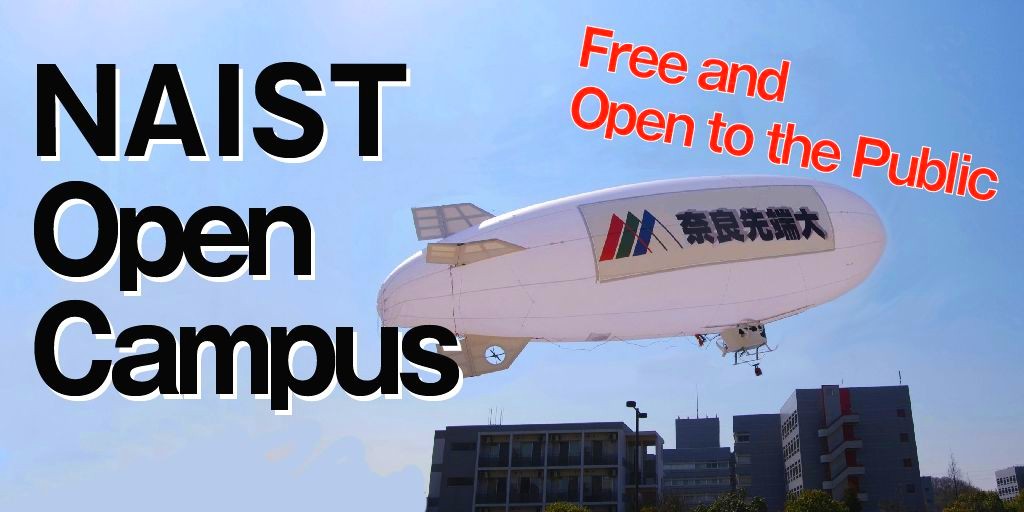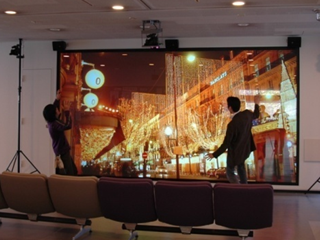|
Computer Science
|
|
We offer education and researches on computer hardware and information network to establish fundamental technologies for the next generation computer science, including dependable and green IT.
|
Computing Architecture Lab.
(Nakashima Lab.)

|
☆Towards Next Generation Triathlon Computer
|
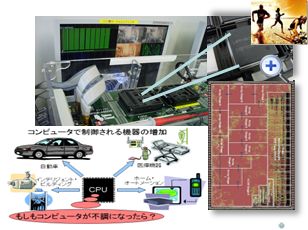
|
Computers going towards either high performance, low power or high dependability have been well developed by scarifying other features.
However, making one with extremely low power, high dependability and capable speed still remains an open topic,
and now it becomes our task to build this next generation triathlon computer.
|
|
Dependable System Lab.
(Inoue Lab.)

|
What is "Dependability"?
|
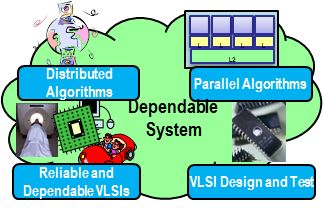
|
We are pursuing research to provide systems that users can depend on. Current research themes include distributed/ parallel algorithms and VLSI design and test. The laboratory introduction and demonstration are held at B413.
|
|
Applied Algorithmics Lab.
(Seki Lab.)

|
The problem is solvable
|
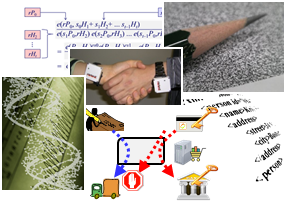
|
We develop mechanisms for computation, and apply them to novel research problems. Software, database, analysis of bio-sequences, security, coding.... Visit us at B507 and check our contribution in many different research areas.
|
|
Ubiquitous Computing Systems Lab.
(Yasumoto Lab.)

|
Cyber Systems Integrating Sensors and Networking Technologies
|

|
Our lab. focuses on systems which provide users with useful services by means of real world data obtained with various sensors.
We demonstrate emergency medical support system, appliances control system, etc. at room A405.
|
|
Foundations of Software Lab.
(Ito Lab.)

|
Future Network Technology
|

|
We are mainly focusing on vehicular networks, cloud computing and mobile computing. We are going to show a demo of 3D video delivery and poster presentation of other research topics at A608.
|
|
Software Engineering Lab.
(Ken-ichi Matsumoto Lab.)

|
Software as Social Infrastructure
|

|
Our research topics include empirically-guided software development, open source software engineering and software security. The demonstrations and posters will be presented at B111 room.
|
|
Software Design & Analysis Lab.
(Iida Lab.)

|
Analysis of Software Design & Development
|
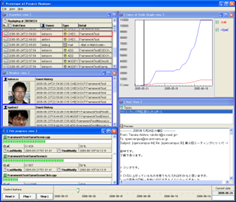
|
We focus on the research and development of tools to analyze software development projects and their source code, using huge computing resources on cloud infrastructures. Our analysis also includes open source software on cloud environments.
|
|
Internet Engineering Lab.
(Yamaguchi Lab.)

|
Let's create �the future of the Internet
|
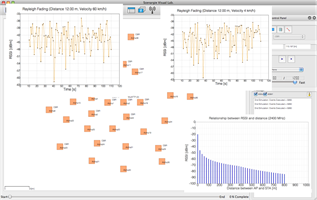
|
Our laboratory is studying new technologies for the future Intenet, e.g., network security, network management/architecture mobile network, mobile applications, and so on. Please visit our lab, A316.
|
|
Internet Architecture and Systems Lab.
(Fujikawa Lab.)

|
Our area is the Internet
|

|
Inet-lab's targets are mobile ITS, sensor, OpenFlow, cryptography and Malware analysis. In this open campus, we demonstrate "TrafficCam"; Sharing Traffic Information on Android smartphone at B206.
|
|
|
Media Informatics
|
|
We offer education and researches on human-machine interaction and media to establish fundamental technologies to support people in advanced information society.
|
Computational Linguistics Lab.
(Yuji Matsumoto Lab.)

|
Japanese Text Analysis and Writing Assistance
|
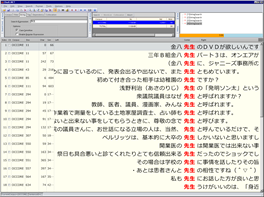
|
We introduce a search engine for Japanese corpus with rich linguistic information and a writing support system for second language learners.
1. Corpus search engine: ChaKi
2. Proofreading tool: Chantokun
|
|
Augmented Human Communication Lab.
(Nakamura Lab.)

|
Toward Enhancement of Human Communication Ability
|
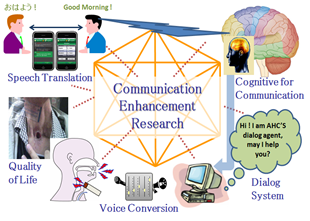
|
Toward enhancement of human communication abilities, AHC lab is studying multilingual speech translation, dialog system, communication QoL, silent speech interfaces, user-adaptive speech recognition/synthesis, and brain analysis related human communication. ( @ B715)
|
|
Network Systems Lab.
(Okada Lab.)

|
Wireless signal processing and sensing
|
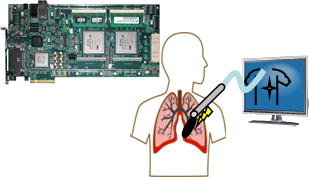
|
Our laboratory is studying various applications using wireless signal processing. A demonstration for mobile receiving for digital broadcasting, minimal-invasive operation system are held at A408 room.
|
|
Vision and Media Computing Lab.
(Yokoya Lab.)

|
Research of CV, VR, MR
|
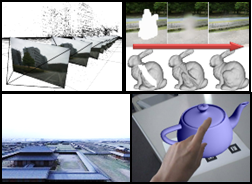
|
Our research fields are computer vision, virtual reality, mixed reality.
�- Camera pose estimation for augmented reality, modeling, novel view generation
�- Augmented Telepresence using aerial omnidirectional video
�- Image, video, 3D inpainting etc.
|
|
Interactive Media Design Lab.
(Kato Lab.)

|
Realization of human-human and human-computer interaction
|
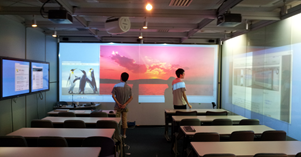
|
Our laboratory is studying about not only the future interactive media itself but also media technologies, human-computer interaction and data engineering which are needed to create innovative interactive media.
|
|
Ambient Intelligence Lab.
(Hagita Lab.)

|
Human-Robot Interaction & Human sensing & modeling
|
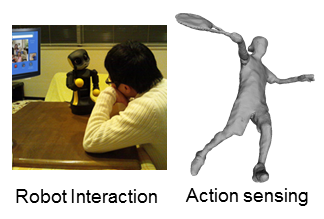
|
Human sensing for understanding when, where, and what people do is crucial for supporting human life by human robot interaction(HRI). Researches of HRI and human sensing would be introduced onsite (A111).
|
|
|
Applied Informatics
|
|
We offer education and researches on computational systems, robotics, and bio-information processing to discover vital function and life phenomena.
|
Robotics Lab.
(Ogasawara Lab.)

|
Dual Arm Robot & Mobile Robot
|

|
We shows demonstration of the mobile robot and the dual arm robot at A111. Also, many experimental equipment (Humanoid robot, Motion capture system etc.) is displayed.
|
|
Intelligent System Control Lab.
(Sugimoto Lab.)

|
Demonstration of Motion Control Experiments
|
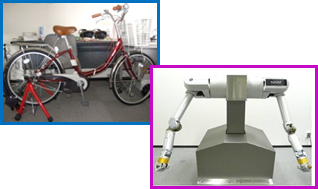
|
Our research interests cover a wide area of System Control, Machine Learning for Control, Mechatronics/Robotics, Sensing & Signal Processing, ranging from basic theory to application.
|
|
Mathematical Informatics Lab.
(Ikeda Lab.)

|
Solutions by Math Model
|
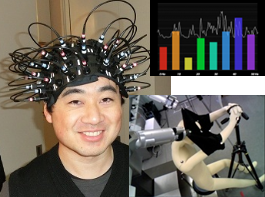
|
Recent sensors, ICTs and signal processing provide us massive data and math model to extract information therein. Our demos include bio-signal processing, assistive robotics and depth sensor applications.
|
|
Biomedical Imaging and Informatics Lab.
(Minato Lab.)

|
High resolution volume visualization
|
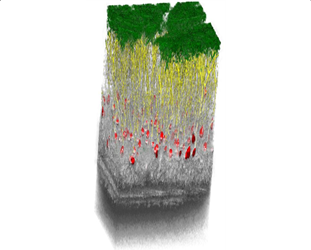
|
We developed a high speed volume rendering method for visualizing a high resolution microscopic 3D images from the two-photon microscopy techniques.
|
|
Computational Systems Biology Lab.
(Kanaya Lab.)

|
Metabolite database "KNApSAcK" family
|
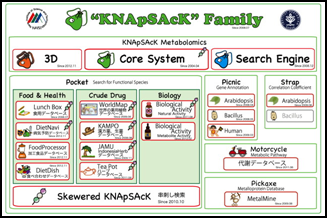
|
The "KNApSAcK" family is an integrated database that contains diverse information about metabolites in plants. Come to the room A506 to see a demonstration.
|
|
Large-Scale Systems Management Lab.
(Kasahara Lab.)

|
Extremely Large-Scale Systems Management
|
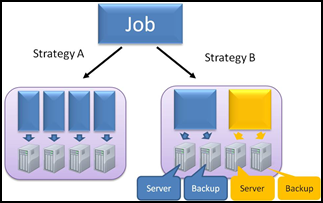
|
Our research is aimed at developing theories and techniques for design, control and architecture of large-scale systems such as computer and communication networks. The demonstrations and posters are held at B707.
|
|
Neural Computation Lab.
(Doya Lab.)

|
Learning mechanism in the brain
|
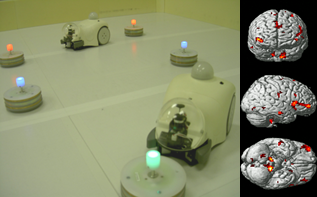
|
How can we learn good behavior through trial-and-error? We aim to understand such a mechanism of our brain by means of neural recording in animals, adaptive robotics, and computational modeling.
|
|
